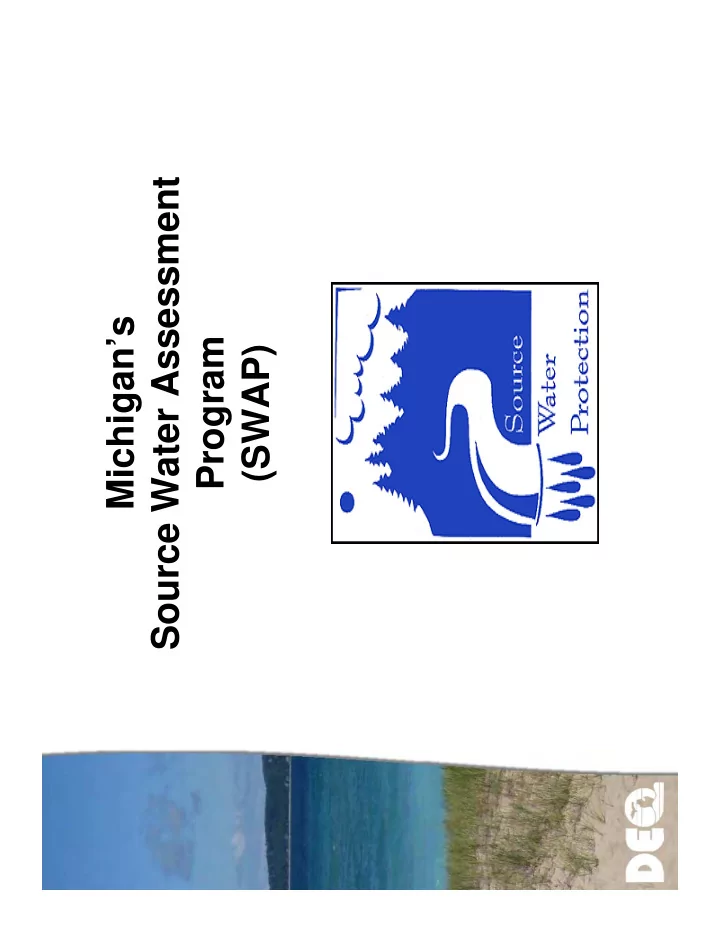

Source Water Assessment Michigan’s Program (SWAP)
1996 Amendments Federal Safe Drinking Water Act Required States to: Identify the areas that supply public drinking water Inventory contaminants and assess water susceptibility to contamination Inform the public of the results
SWAP Advisory Committee Consisted of MDEQ, MSU-IWR, USGS, GEM Centers, local health department staff, and others Final SWAP submitted in February 1999 and approved in October 1999 Michigan has approximately 12,000 PWS and over 18,000 sources to assess
MICHIGAN SWAP Water Supply “Assessment” Categories Wellhead Protection Programs – Community systems served by groundwater Surface Water Assessments – Community systems on: Inland lake and river sources Great Lakes sources Source Water Assessments – remaining Community systems served by groundwater sources Source Water Assessments – Noncommunity systems served by groundwater sources
Source Water Assessments Groundwater Sources Source Water Assessments On-site Assessment – Scoring Process GPS Locating of Wellheads Well Log Verification Non-community Systems Conducted by Local Health Departments Community Systems Conducted by DEQ district staff
Why are we updating SWA’s? Required by Federal SDWA Maintaining state waiver program More information available Well logs Detection limits have changed Change in drinking water standards MGMT Provisionals provide SWPA No longer rely on isolation distances
GW Flow-Based Delineation vs Fixed Radius
Source Water Assessment Scores (SWAS) Evaluation process critiques: Geology - SWASg Well Construction - SWASw Chemical Monitoring - SWASc Source of Contamination – SWASs SWAS = SWASg + SWASw + SWASc + SWASs Generally, the lower the SWAS the less susceptible system is to contamination
Typical Well Installation Age of Well Grouting (casing seal) Geology Pump Size Casing Depth
Well Log Info Information from Water Well and Pump Record Age of Well Pump Size Casing Depth Geology Grouting
Geology - SWASg Degree of natural protection by geologic materials present Presence or absence of “confining” materials Continuous Confining Material (CCM) Requires 5 feet or more – clay, shale, etc. Continuous Partially Confining Material (CPCM) Requires 10 feet or more – clay & sand, limestone & shale, etc. SWASg - 30 minus points for CCM & CPCM Geologic Sensitivity Rating (GSR) High: SWASg = 30 (CCM & CPCM absent) Low: SWASg =0 (Excess of CCM or CPCM) Moderate: 3 < SWASg < 27 (everything in between)
SWASg - WSSN 2059341 CPCM CCM (- 3 pts) (- 9 pts)
Well Construction - SWASw Represents the relative degree of protection afforded by the construction of the well Evaluation considers: Grouting of casing – sealing of the well in construction Age – the newer the better Casing Depth – deeper the better Pumping Rate – high pumping rates create greater risk
SWASw - WSSN 2059341 Grouting Age Casing Depth Pumping Rate
Water Chemistry - SWASc Points are accumulated for chemistry detects Chemical Parameters Nitrates and nitrites Volatile Organic Chemicals Synthetic Organic Chemical Point Range Not detected – 0 points Present at low levels – 10 points Present at moderate (action) level – 20 points MCL Violation – 50 points
SWASc - WSSN 2059341 System Score Indicates: Nitrates and Nitrites – present at low levels VOCs – no detects
Sources of Contamination - SWASs Major Sources within SWPA – 10 points Consists of LUST, 201 sites, Oil & Gas, etc Major Sources in Standard Isolation 20 points Community: within 200 feet Regardless of location within SWPA Std. Sources in Standard Isolation – 10 points Community: within 200 feet Known Sources within SWPA – 25 points
SWASs - WSSN 04754 System Score Indicates: No major potential sources within SWPA No major potential sources within 200 ft Two standard sources within 200 ft One known source within SWPA Inventory within Provisional WHPA could replace the inventory relative to isolation distances
SWASs - WSSN 01465 System Score Indicates: No major source in major isolation No major sources in standard isolation No standard sources in standard isolation No known sources in major isolation
How might the Source Water Assessment Change? Consider Woodruff Lake Co-Op Apts.
2005 Source Water Assessment Geology a guess Owner Information No Well Record
2005 Source Water Assessment cont’d Sources in Isolation (Note “majors”)
Information from Water Well and Pump Record Age of Well Pump Size Casing Depth Geology Grouting Water Well Record now In Wellogic database
2014 Source Water Assessment Well Record Geology from Well Record Construction from Well Record
2014 Source Water Assessment cont’d Chemistry is same Major Sources not in Provisional WHPA
SOURCE WATER ASSESSMENT SUSCEPTIBILITY DETERMINATION Describes likelihood of a contaminant impacting a source of drinking water Susceptibility Determination Categories Very Low Low Moderately Low Moderate Moderately High High Very High
SOURCE WATER ASSESSMENT SUSCEPTIBILITY DETERMINATION Describes likelihood of a contaminant impacting a source of drinking water Source Water Assessment Score – 58 points Susceptibility Determination
Source Water Assessment Program (SWAP) SWA completed from 2000 to 2005 13,755 source water assessment reports Assessments completed for 12,108 Community and Noncommunity public water supplies DEQ is now trying to revisit this process as part of WHPP efforts using MGMT
Moving from Assessments to Protection The Environmental Protection Agency (EPA) is encouraging states to move from Assessments to Protection The DEQ is using data from the Source Water Assessment Program to target protection efforts YOU can play a role in protecting your drinking water supply !
Recommend
More recommend